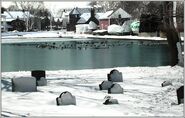
By Jennifer Beaulieu
History[]
The Old Burial Hill was created in Marblehead, Massachusetts in 1638 at the site of Marblehead's first meeting house. Buried there are an estimated 600 Revolutionary Soldiers, only a few of their graves are marked. The graveyard has creatively designed headstones that reflect the times of the Puritians. Buried here were soldiers, fishermen, sea captains, victims of the Salem Witch Trials, wives, and children. It is believed the graveyard is no longer accepting new burials. The place is still maintained and has three entrances; one on Orne Street, the second is nearby on Pond Street, the third is by Red's Pond (Kane, 2012).
Noteable People Buried[]

Wilmot Redd by Jennifer Beaulieu
Wilmot Redd[]
In Salem Village in 1692, several hysterical girls were believed to be affected by witchcraft. Several woman and a few men were hanged and accused of witchcraft. One of the victims was Wilmot Redd. She was an old woman who was married to local fisherman Samuel Redd. A warrant for her arrest was made by John Hathorne and Jonathan Corwin. On May 31st, she was taken to Salem Village for preliminary examination. Later that day she was indicated and then placed in jail. She was set for trail four months later, where she denied the charges but was allowed no defense counsel. On September 17th she was condemned to hanging. Four days later, she and seven others were hanged on either Gallows Hill or some other nearby hill. She was the only Marblehead citizen executed for witchcraft. Her house is near the pond she was named after. The hourglass on her gravestone symbolizes kindness (Kane, 2012).
The Cushman Family[]
A monument was made for the Cushman family. It is a 25 foot grantile column, with four sides of bronze

by Kurt Moser
plates.
Robert Cushman[]
The bronze plate on the Nothern side reads
"ROBERT CUSHMAN,Fellow exile with the Pilgrims in Holland,Afterwards their chief agent in England,Arrived here IX November, MDCXXI,With Thomas Cushman his son:Preached IX-. December,His memorable sermon on "the Danger of self-loveAnd the sweetness of true friendship:"Returned to England XIII December,To vindicate tho enterprise of Christian emigration;And there remained in the service of the Colony Till MDCXXV,When, having prepared to make Plymouth His permanent home." (Perkins, 1896)
The West side reads
"He died, lamented by the forefathers as "their ancient friend, - who wasas their right hand with their friendsthe adventurers, and for divers yearshad done and agitated all their businesswith them to their great advantage." "And you, my loving friends, the adventurersto this plantation, as your care has been firstto settle religion here before either profitor popularity, so, I play you, go on. --I rejoice -- that you thus honor Godwith your riches, and I trust you shall be repaid again double and treble in this world, yea,and the memory of this action shall never die."DEDICATION OF THE SERMON." (Perkins, 1896)
Thomas Cushman, Sr.
The bronze plate on the South side reads
"Son of Robert, died X December, MDCXCI, Aged neatly LXXXIV years. For more than XLII years he was Ruling Elder oú the First Church in Plymouth, By whom a tablet was placed to mark his grave on this spot, Now consecrated anew by a more enduring memorial." (Perkins, 1896)
Mary
The bronze plate on the South side also reads
"MARY,widow of Elder Cushman, and daughter of Isaac Allerton, Died XXVIII November, MDCXCIX, aged about XC years,The last survivor of the first comers in the Mayflower." (Perkins, 1896)
The bronze plate on the East side reads
Erected by The descendants of Robert Cushman In memory of their Pilgrim Ancestors, XVI September, MDCCCLVIII. (Perkins, 1896)
Dr. Le Baron[]
He was a Surgeon on a French ship which was wreaked in Buzzard's Bay in 1694. He was taken prisoner with the officers and crew and sent to Boston. On their way to Boston, they stopped at Plymouth where he performed a surgery, which led to a request by the citizens lieutenant-governer for him to be allowed to stay. By his side is his wife Mary's grave who married a Wait after the doctor died. Nearby his son Dr. Lazarus Le Baron. In the rear of all these graves is the tombstone of Nathaniel Goodwin, the great-grandfather of Mrs. Jane Austin, who married Lydria, daughter of Lazarus Le Baron (Perkins, 1896).
Gravestone designs[]

Mr.Joseph by Jeff Kane
Winged Death's Head
Most common is the skull with wings. Older gravestones have the skull with hallowed out eyes and rows of teeth, some had wings and some had crossbones, while younger gravestones are more angel-like. The skull symbolizes death, while the wings symbolize the soul's migration or the soul leaving the body.
Urn and willows[]
Human Head or Human Body[]
Willows[]
Urn[]
Colors[]

by Jeff Kane
Blueish-gray and Dark Gray[]
Was used during the 1600s and 1700s, made from Stale
White[]
Used during the middle of the 1800s, made from Marble
Maintence and Preservation[]
Grounds are often maintained, and bad damaged gravestones are encased in granite to repair and protect the gravestones. Due to weather, some gravestones are hard to read. Some tombstones have been cracked, rised above the height they were when placed, some have been knocked over, and some have sunk below the height thye were placed at.












